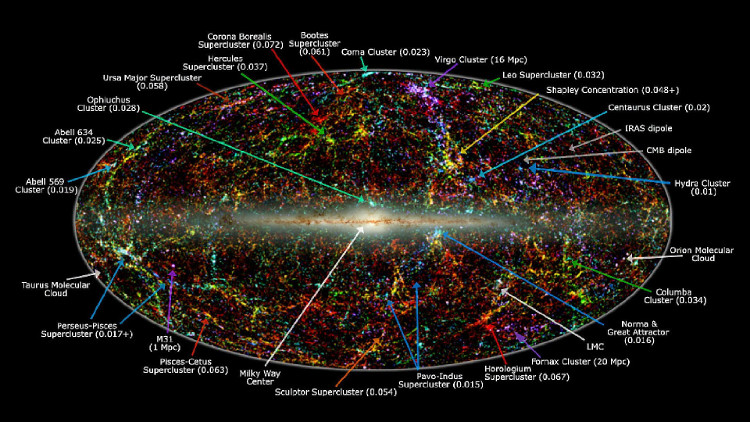Published the largest universe history map ever
An international team of astronomers from the Sloan Digital Sky Project (SDSS) created the first large-scale map of the universe's structure , helping to promote research on dark energy as well. as decoding the mysteries of the universe's expansion.
To create this map, the team brought together experts from many countries who used the Sloan Telescope to observe a large number of quasars , extremely bright bodies and far away from the Earth.
When matter and energy fall into the black hole of a quasar, they are heated to high temperatures and start glowing. Telescopes on Earth capture these lights and from there scientists will calculate the distance of quasars, then rely on the information to create a three-dimensional spatial map of taste. the position of the quasars.
Quasars are so far away from the Earth that when light starts to leave from these celestial bodies, the universe forms about 3-7 billion years, at which time the Earth did not yet exist.

Scientists use the Sloan telescope to observe a large number of quasars and extremely bright bodies. (Artwork: apod.nasa.gov).
This is a particularly important stage because it starts the period when the expansion of the universe changes from deceleration to acceleration. Understanding exactly the nature of this transfer can lead to deciphering the nature of "dark matter" - the dominant element of the universe at the present time.
In the first 2 years of implementing the Baryon Oscillation Spectrum Survey (eBOSS) under SDSS project, astronomers measure the precise three-dimensional spatial positions of more than 147,000 quasars.
And to use this map in the study of the universe's expansion history, scientists need the "measure" of Baryon negative vibrations (BAO) , a strange phenomenon that occurs in the universe and leaves space sound "streaks" .
At the new stage of formation, when the structure of the universe is much thicker and hotter than it is today, the sound waves travel.
However, at the time of the 380,000-year-old universe, the sudden change in environmental conditions caused these sound waves to "freeze" in place and leave traces in the three-dimensional space of the universe until the day. now on.
Experts also said the new study strengthens the standard cosmology model built by researchers in the past 20 years.
Accordingly, the universe operates according to what Albert Einstein argued in the theory of relativity, but includes other factors that scientists still cannot clearly assess.
The project to build the universe map is still in the final stage. The eBOSS experiment uses the Sloan Telescope at the Apache Observatory located in New Mexico, USA.
- The most impressive findings about the universe in 2012 (2)
- Space History will be rewritten?
- The 'dying' of the largest star in the universe
- Australia launched the largest naval warship in history
- Discover the largest celestial object cluster in the universe
- 4 scenario is happening when the largest iceberg in history has just broken in Antarctica
- Revealing the largest galaxy in the universe
- The largest structure in the universe contains just 1,600 galaxies
- Identify the largest carnivorous dinosaur
- Astronomers map the history of the Universe
- New hypothesis of cosmic formation
- Identify the universe
 Van Allen's belt and evidence that the Apollo 11 mission to the Moon was myth
Van Allen's belt and evidence that the Apollo 11 mission to the Moon was myth The levels of civilization in the universe (Kardashev scale)
The levels of civilization in the universe (Kardashev scale) Today Mars, the sun and the Earth are aligned
Today Mars, the sun and the Earth are aligned The Amazon owner announced a secret plan to build a space base for thousands of people
The Amazon owner announced a secret plan to build a space base for thousands of people World's most powerful telescope captures something that threatens to upend cosmology
World's most powerful telescope captures something that threatens to upend cosmology  We Are the Neurons of the Universe: A Creation Theory Reveals the Mysteries of the Universe and the Brain
We Are the Neurons of the Universe: A Creation Theory Reveals the Mysteries of the Universe and the Brain  NASA releases video about the evolution of the universe after 12 years
NASA releases video about the evolution of the universe after 12 years  'Time-traveling assassin' 13 billion years ago kills an entire galaxy
'Time-traveling assassin' 13 billion years ago kills an entire galaxy  The Shape of the Universe Isn't What You Think: From Ancient Round Sky to Modern Three-Dimensional Donut
The Shape of the Universe Isn't What You Think: From Ancient Round Sky to Modern Three-Dimensional Donut  What controls the movement of galaxies?
What controls the movement of galaxies? 